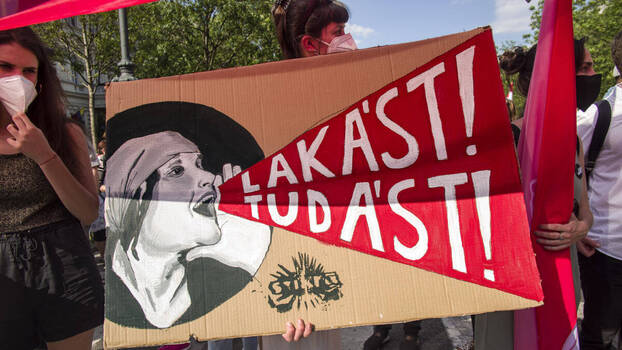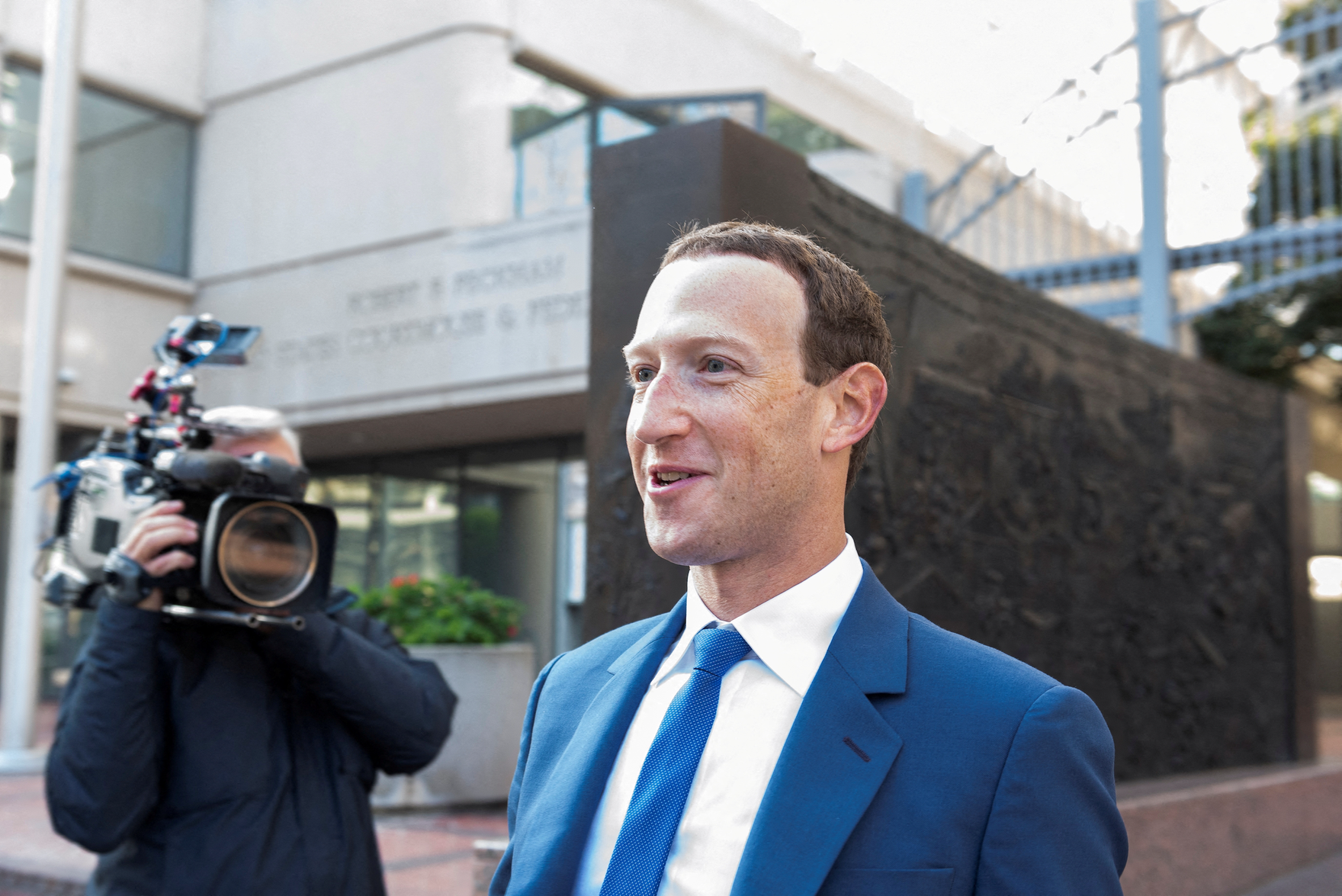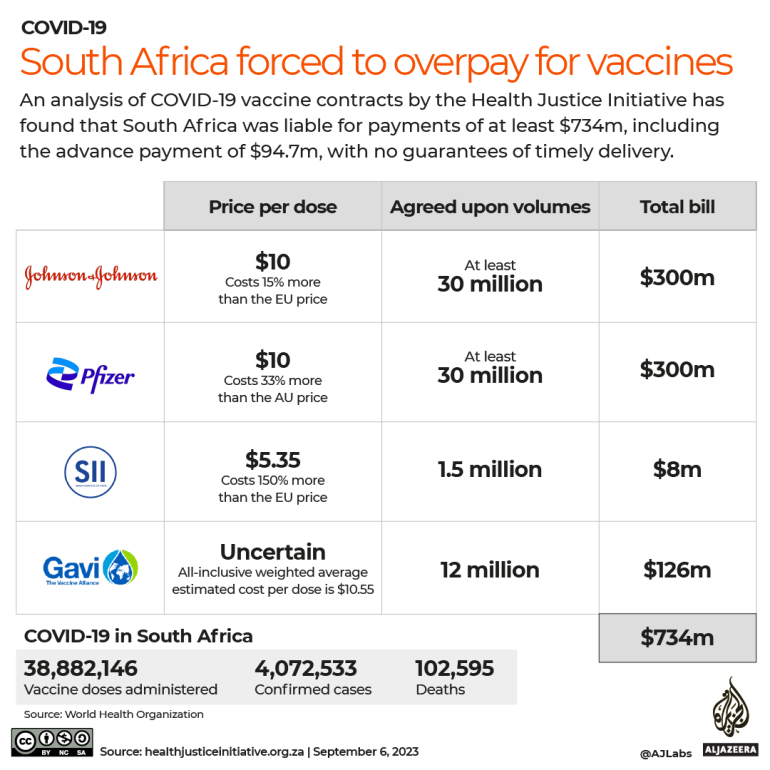In Hungary, a fledging New Left is rebuilding amidst the ruins of Orbánism
AUTHOR
Áron Rossman-Kiss
 Members of the left-wing group Szikra demonstrate against the Orbán government’s plan to bring Chinese Fudan University to Budapest, 5 June 2021
Members of the left-wing group Szikra demonstrate against the Orbán government’s plan to bring Chinese Fudan University to Budapest, 5 June 2021On a warm morning in June this year, a small group made its way through the streets of Tatabánya, a midsize post-industrial town an hour northwest of Budapest. They were in a hurry — the eviction was scheduled for 11:00.
Áron Rossman-Kiss is a Budapest-based researcher, artist, and activist in Szikra, a left-ecological political movement in Hungary.
They reached the flat, two scruffy rooms on the second floor with enough time to talk things through with the tenant, Erzsébet, put their backpacks in a corner, post a handmade slogan on the door that read “A HOME FOR EVERYONE”, and form two short rows in front of the entrance. Then, they waited for the police to show up who would probably, inevitably, remove them one by one, seal the door, and leave Erzsébet on the streets. A middle-aged woman, she had lived in the flat since the 1990s and fallen into arrears in the past years. These days, she worked as a cleaner.
“There’s little chance we’ll succeed — five percent, tops”, the activist in charge of the action explained. The municipality would simply not budge, despite attempts to find a solution by advocacy groups, politicians, and charities in the previous days.
The group formed two rows in front of the entrance. Shortly after 11:00, a man walked up the stairs with an assistant carrying a drill. Bailiffs? The group jeered and took photos. Policemen walked halfway up the stairs a few times, waited downstairs, and fined a driver who had illegally parked. A woman carrying a document stopped in the hallway. Intermittently, a member of the group livestreamed the scene. They made calls. Hours passed.
Soon after, the news came through back-channels, first tentative, and still hesitant when it became official: the human chain had worked. The eviction was deferred.
A Snapshot of Modern Hungary
The group that stopped the eviction on that day was formed of members of Budapest-based housing rights group The City is For All (AVM), activists affiliated with Párbeszéd (“Dialogue”), the Green Party, and Szikra (“Spark”), a left-green movement. The livestreaming activist was MP András Jámbor, a Szikra candidate elected to parliament against all odds in April 2022. Successfully halting an eviction remains a rare feat in Orbán’s Hungary, and particularly so outside of Budapest. But besides the outcome, that morning’s circumstances give a clear snapshot of Hungary’s present.
Just like in other countries of the former Eastern Bloc, the once state-owned housing stock in Hungary was almost completely privatized following the 1989 regime change. In the absence of political strategy or will — Hungary has not had a housing ministry or unified housing agency in the past 30 years — every crisis immediately ripples through already precarious housing arrangements.
This is particularly true in places like Tatabánya. Although the long downturn of the 1990s hit other regions harder, it still saw the closure of its heavy industry and mining, leaving its inhabitants with much reduced prospects. Much of the middle class that formed in the upturn of the 2010s moved to nearby suburbia. State-funded houses of culture, once central to community life, have closed, educational access stymied, and the population finds itself in steady decline.
As social services have been hollowed-out, falling into debt the way Erzsébet did often becomes an inevitable trap, even more so for those relying on irregular, informal jobs. Living in one of the remaining social housing units should have offered her a layer of protection, particularly in a city that elected an oppositional mayor in 2019. But as in similar municipalities, most of the mayor’s term has been marked by infighting within local opposition ranks, the absence of a social vision, and the incapacity and unwillingness to build a political movement in the face of the unrelenting hostility of the Orbán regime. No wonder a semi-privatized system for debt collection geared towards profit — and intertwined with the highest state authorities — thrives in such a context.
A welfare system catering to the needs of the middle and upper classes, growing inequality, a private-public nexus of greed and cruelty, indebtedness, and emigration all characterize Hungary midway through the fifth Orbán government — together with a largely disoriented and toothless opposition. Stopping the eviction of a single woman might appear like a minor change in such circumstances, but it shows that a handful of resolute activists can make a difference in people’s lives. It is upon such small victories that the Left must build to both inspire and mobilize towards a genuine alternative.
The True Face of Orbánism
Erzsébet’s situation is hardly an anomaly in contemporary Hungary. As we approach the middle of Orbán’s fourth mandate since his return to power (he also served as prime minister between 1998 and 2002), inflation in Hungary is by the far the highest in the EU, nearly double that of the second-highest country. Food prices have risen by over 30 percent. Real wages have been in decline for almost a year, while many companies rack up exceptional profits.
Isolated internationally and in increasingly dire economic straits, Orbán unleashed a stringent pack of austerity measures, raising taxes while slashing most of the meagre social support and subsidies established over the last decade. In the last weeks alone, the government scrapped price caps for designated food products, enacted additional taxes on pharmaceutical goods, massively reduced the capacity of the postal service, and shut down train lines. Moreover, despite a prolonged social movement among teachers throughout the country (a starting teacher’s salary is less than 700 euro), the government’s supermajority voted to end their status as public servants, further pushing the educational sector into precarity. A few weeks after the vote, the government’s spokesperson blamed the country’s poor results in reading comprehension on Roma children.
After 13 years, the Orbán regime reigns less through mobilization than through apathy, arbitrary and centralized decision-making, and the unceasing churning of a media machine controlled by the ruling party. But just as state and party have become inextricably intertwined, state capacity has also been profoundly hollowed out in key sectors such as education, health, and basic infrastructure. Little wonder that the level of COVID-related excess mortality was shocking even in global comparison.
There’s no denying the system’s blatant cronyism and corruption, but no regime can survive on coercion and brainwashing alone. Neither does propaganda produce docile subjects out of thin air.
Indeed, this is the true nature of a regime that has seemingly delighted in the confusion its hybrid nature breeds among commentators, academics, and politicians — friend and foe alike. It is true that the regime’s own propaganda has created a kind of political force field of its own, buoyed by the sycophantic embrace of a far-right international that sees Budapest as a bastion of the West, whiteness, family, and tradition. Moreover, it is also true that a superficial glance at some of its measures — such as the re-nationalization of energy providers and the pension system — could lead to see potential signs of a redistributive or developmentalist agenda. But if Orbán pointedly attending Thatcher’s funeral wasn’t evidence enough, perhaps Hungary’s flat tax system, the hollowing-out of social services, and its draconian anti-labour laws offer some indication of the true political economy of the Orbán regime.
And yet, just as most Hungarians never voted for the sweeping marketization that took place after 1989, opinion surveys consistently confirm that most of the population favours higher state investment in the kinds of social welfare and redistributive policies that are anathema to the government. By now, even an issue such as gay marriage — ardently demonized by the government and its propagandists — is supported by a majority of the population. Despite this, mobilization against Orbán’s Fidesz party has only been sporadic. Many protest movements were unable to catalyse widespread anger and support, or simply reverted to liberal platitudes once their momentum had.
How to explain such a seeming contradiction? Much blame can be attributed to the opposition’s echo chambers. It also is impossible to underestimate the role of censorship and fake news spewed by the government-controlled public media system. Complicit transnational firms and a shift in global industrial policies have been decisive.
Similarly, the EU’s complacency is painfully clear: the European Commission and Council have knowingly postponed the decision to freeze financial transfers until recently, despite the fact that the systematic funnelling of these funds to Orbán’s cronies has been amply documented over the past 14 years. Finally, the first years of the regime also saw a reorganization of the economy that brought material benefits — however precarious and uneven — to a segment of the population that went well beyond a small coterie of insiders.
The Golden Years
Orbán’s first years in office remain crucial to his power. To this day, much of the regime’s legitimacy is built on the memory of the late 2000s (a trauma repeatedly invoked by pro-government media). Hungary’s openness to global flows of capital — once heralded by local elites and international institutions as proof of its development — also meant that the country was extremely vulnerable by the time the 2008 financial crisis came crashing down.
As a nominally Socialist-led government under Prime Minister Ferenc Gyurcsány followed by an unelected “technocrat” enacted harsh austerity measures and wide-scale privatization, hundreds of thousands of citizens lost their jobs, savings, and future prospects. Many defaulted on foreign currency-denominated mortgages and found themselves trapped between squalor and casual jobs, joining the flexible labour market in the EU’s Western core, where an expendable workforce from the East proved essential in maintaining a semblance of normalcy amidst the neoliberal dismantling of state structures.
In the face of the Socialists’ tone-deafness and pressure and deception on the side of international institutions such as the EU and the IMF, social dislocation ensued, exemplified by countless evictions, murders of Roma citizens, and the rise of far-right militias. Fidesz’s “Hungary First” discourse proved unsurprisingly popular in such a context. But this was not merely a question of finding the right narrative: during its years in opposition, the party had effectively built a nationwide movement capable of mobilizing a wide cross-section of a society largely disenchanted with the broken promises of 1989.
For all of Orbán’s political acumen, his party’s rise would not have been possible without a political reorientation among a large section of the Hungarian economic elites. In Poland, a disgruntled comprador class allied with a resurgent nationalist Right in the guise of the Kaczyński brothers’ Law and Justice Party (PiS). In Hungary, Fidesz managed to broker a deal with a national bourgeoisie that felt pushed aside by transnational firms’ dominance over domestic markets, while simultaneously creating a haven for international investors in strategic sectors.
This has led to a two-pronged economy: on the one hand, special economic zones and tax breaks have facilitated a reindustrialization via foreign-owned, export-oriented, low-value added (largely automotive, most often German) industry. While German companies with Hungarian subsidiaries may sometimes pay lip service to liberal democratic norms (for instance, berating the Hungarian government for its homophobic propaganda), German industrial interests are firmly aligned with — and catered to by — the Orbán government. On the other hand, state intervention has facilitated accumulation for the Hungarian bourgeoisie in sectors such as construction, tourism, and banking. In this process, rather than marginalizing the state, increased financialization has led to steeper power verticals, reorienting the state’s overlap with the market.
The Foundations of Fidesz’s Power
After more than a decade in power, Orbán has carved himself an outsized persona in global politics, often removed from the actually existing Hungary his system has created. As such, what happens in the country has reverberations far beyond Hungary itself. This is not only the case for ideological battles — even as the regime’s economic structure unravels, it will certainly remain a key battleground for the future of Europe.
As the EU’s green industrial policy has in effect been largely outsourced to private companies, Hungary has become a key site for the production of electric batteries in recent years. Established through governmental decrees and shrouded in secrecy, they have also been the site of worker abuse and lack of democratic consultation with affected communities. As such, they represent a dire harbinger of what a for-profit “green politics” stripped of accountability, redistributive elements, or wider consideration for ecosystems might bring — and one to which the Left must provide clear and progressive alternatives.
Despite widespread dissatisfaction and the destruction of basic social services, we cannot take the Orbán regime’s demise for granted. In these circumstances, Szikra and the broader Hungarian Left have to offer both concrete forms of resistance and support as well as a long-term political horizon to which they can aspire.
While often justifiably indignant, many critics still dismiss the regime as an authoritarian contraption under which all (bar a closed circle of insiders) are condemned to suffering and silence. Indeed, there’s no denying the system’s blatant cronyism and corruption — the sheer number of childhood and university friends, family members, and grifters of all kinds suddenly elevated to positions of power is staggering, but no regime can survive on coercion and brainwashing alone. Neither does propaganda produce docile subjects out of thin air.
Orbán’s tenure coincided with the release of an extended EU Cohesion Fund and slight but steady growth throughout the bloc. Industry brought jobs. Under the guise of a pro-natalist programme, the government engineered a construction boom (tailored for the middle and upper classes.) The much-vaunted public works system reinforced existing inequalities and offered neither avenues towards education nor integration into the labour market. But in regions entirely abandoned by previous governments and blighted by long-term unemployment, it was often seen as more than nothing. A cap on utility bills proved immensely popular — even if investment in retrofitting or renewable energy communities would have provided similar savings in the long run (and could not have been terminated from one day to the next with the stroke of a pen).
As the EU’s financial transfers and indolence facilitated the regime’s entrenchment, these political successes were endlessly trumpeted in an increasingly centralized public media system. The dissonance between official propaganda and everyday reality was often adeptly highlighted by the far right, all the while the government curtailed the right to strike and demonized even the mildest social measures. Crucially, this status quo was never subjected to a serious challenge from the Left.
Sparks of Hope on the Left
Under Orbán, the once-dominant Hungarian Socialist Party (MSZP), which facilitated widespread marketization and deindustrialization throughout the 1990s and the 2000s, has seen its base wiped out as it ambles aimlessly to the rhythm of defections and ideological disarray. The two fratricidal green-liberal parties, Hungary’s Green Party (LMP) and Párbeszéd, never formulated coherent political platforms, and years of infighting have left them both in tatters. The strongest opposition party today thus remains none other than former PM Gyurcsány’s Democratic Coalition (DK). After losing four general elections in a row, he has seemingly settled with attempting to rule over the opposition instead.
In a cruel twist, the electoral system devised by Fidesz has de facto forced all these parties — including the arch-liberal Momentum and reformed (but not repentant) far-right party Jobbik — to collaborate in order to have any chance of challenging the ruling party. Confusion was inevitable: during the spring 2022 general elections, the united opposition’s programme did contain a few socially minded proposals, but it was headed by a conservative candidate who all but disavowed them, professed admiration for Orbán’s flat tax, and singled out corruption as the only reason for Hungary’s woes. The electoral results were, perhaps predictably, abysmal.
If, a few exceptions aside, the Left has made only little electoral inroads in Hungary during the past decade, a lively left-wing scene has nevertheless emerged. Still small, Budapest-centric, and inevitably beset by fierce disagreement, it has nevertheless contributed to broadening the terms and possibilities of political imagination.
Mérce, an online news portal, offers invaluable reporting and commentary from a variety of critical and left-wing perspectives. The openly left-wing YouTube channel Partizán has emerged as one of the most important media organs in the country. Institutions and initiatives such as the Solidarity Economy Centre (SZGK), Periféria Központ, Helyzet Műhely (Working Group for Public Sociology) or Közélet Iskolája (School for Public Life) do tireless work, organizing, and research. Gólya Cooperative and Auróra are two community centres that offer precious space and opportunities for a variety of progressive initiatives. AVM has effectively empowered homeless people alongside allied activists as part of the struggle for just housing. And while trade unions are historically weak and hopelessly divided, strong individual voices have emerged from the labour movement in recent years as well.
Szikra emerged from this milieu, but in contrast to the wholesale rejection of institutional politics professed by many on the Hungarian Left, its members have always seen it as a necessary terrain of engagement — however fraught, hostile, and hollowed-out. Its forerunner, Szabad Budapest, supported left-of-centre candidates in municipal elections in 2019, including the current Mayor of Budapest Gergely Karácsony. The movement was officially formed as Szikra in 2020.
During a lull in COVID lockdowns, it organized one of the most significant demonstrations of the past few years, a protest against the planned building of a local branch of the Chinese state-run Fudan University. But whereas much of the mainstream opposition’s criticism resorted to hackneyed racism and orientalist clichés, Szikra instead used the case to place the question of housing at the centre of a public debate, as the campus was to be built on the location of long-planned and acutely needed student dorms. The construction of the campus has since been indefinitely put on hold.
The Long March through the Institutions
In the opposition primaries of autumn 2021, Szikra nominated András Jámbor, the founder and former editor-in-chief of Mérce, as its candidate in Budapest’s XIII–IV district, the poorest and most unequal part of the inner city. Raised by a social worker single mother, Jámbor built a campaign focused on solutions to local inequalities, the housing crisis, and tensions caused by creeping gentrification. Running on an openly left-wing platform, he roundly defeated his opponents in the primary.
In the run-up to the 2022 elections, the government poured an extraordinary amount of resources into the district, which had been a stronghold of Fidesz potentate Máté Kocsis, amplifying its disinformation campaign, routinely harassing volunteers, and tearing down Jámbor’s electoral placards. And yet, the campaign managed to mobilize the largest number of volunteers in a single district in all of the country. On the very night when Orbán raked in his fourth supermajority in a row, Jámbor flipped the district by a decisive margin, showing that the Left could still resonate, mobilize, and inspire in Hungary today.
In the face of mounting pressure, Szikra has not backed down.
Being an MP in a regime that has effectively hollowed out parliamentary deliberation brings with it a series of conundrums. In this context, Jámbor has used the visibility offered by his position to tirelessly raise issues related to the cost of living crisis, social injustice, and labour struggles, quickly becoming one of the most recognizable faces of the opposition. But his work has also gone beyond such interventions, whether in decisively vouching for the inclusion of pre-paid utility meters (used predominantly in social housing) into the new utility cost regulations, or in implementing a household energy assistance programme in his district.
Because participation in institutional politics allows access to visibility and funds otherwise inaccessible, Szikra will also field candidates for the 2024 municipal elections both in Budapest and smaller cities. But gaining electoral representation cannot be an end in itself. In a country where the alienation wrought by politics has been essential to Fidesz’s grip on power, Szikra has sought to build a political community that can offer support and socializing opportunities for its members alongside concrete forms of action.
Structured around a strong mentorship programme, the several-hundred-member-strong movement organizes a host of educational activities and events both internal and open to all. In parallel to street actions that highlight social injustices, it also seeks to collaborate with other social movements, trade unions, and civic initiatives. This spring, it co-organized a day-long May Day programme together with SZEF, one of the independent trade union federations. Since then, it organized a campaign denouncing the racketeering system of debt collection. Municipal campaigns are gradually gathering strength.
Rebuilding a Shared Sense of Hope
As the contemporary examples of Putin’s Russia and Erdogan’s Turkey show, autocratic regimes can continue well after the social contracts that constituted their foundation collapse. Indeed, against the backdrop of unprecedented climate breakdown and the unravelling of liberal democracies, perhaps such death spirals are becoming the norm.
Despite widespread dissatisfaction and the destruction of basic social services, we cannot take the Orbán regime’s demise for granted. In these circumstances, Szikra and the broader Hungarian Left have to offer both concrete forms of resistance and support as well as a long-term political horizon to which they can aspire. Going forward, the challenge for the movement will be one shared by left-wing movements worldwide: mobilizing a largely non-union labour force, meaningfully repoliticizing a hollowed-out public sphere, offering concrete solutions and networks of solidarity that go beyond reactive acts of resistance, and creating institutions capable of pushing for an inclusive green transition built around and for communities. It’s a difficult but necessary task. One that necessitates day-to-day, often tedious work, the rebuilding of trust and of a shared sense of hope.
Meanwhile, faced with multiple crises (many of its own making), an increasingly erratic and vindictive Orbán regime is increasingly clamping down on any form of dissent. In early August, two weeks before Szikra’s annual summer camp, the venue caved into political pressure and cancelled the event. A few months earlier, a 42-year-old woman active in the movement was imprisoned on bogus charges for two weeks in the aftermath of incidents surrounding a tacitly approved neo-Nazi march.
The march marked the escalation of a coordinated campaign against the movement and András Jámbor, which has relied on the full force of state-controlled media to smear the organization as violent, foreign-backed, and even paedophilic. These are no idle threats coming from a government whose use of the Pegasus software against journalists and opposition has been amply documented, that directly controls courts and has a proven record in whipping up hateful hysteria. The direct line between open threats professed in parliament and a death threat received shortly thereafter should be clear to all.
And yet, in the face of mounting pressure, Szikra has not backed down. As it was being ceaselessly maligned through the regime’s loudspeakers, its activists made their way to Tatabánya on a June morning. They stopped an eviction. In the next weeks, the movement’s campaign gathered enough money to pay off a substantial amount of Erzsébet’s debts. It looks like she’ll be able to keep her home, as we all should be able to.







:quality(70)/cloudfront-eu-central-1.images.arcpublishing.com/thenational/RT6GOAYNLCOBULDA7RP4S6YSQA.jpg)
:quality(70)/cloudfront-eu-central-1.images.arcpublishing.com/thenational/HAYQ7IYPPN34DIBTCNQ6WD454I.jpg)


